The Independent's journalism is supported by our readers. When you purchase through links on our site, we may earn commission.
Follow your tastebuds to find the hidden Algarve, a foodie’s paradise far from the madding crowd
Better known for its beaches and golf courses, Portugal’s deep south has an undiscovered hinterland. Joanna Booth eats and drinks her way off the tourist trail
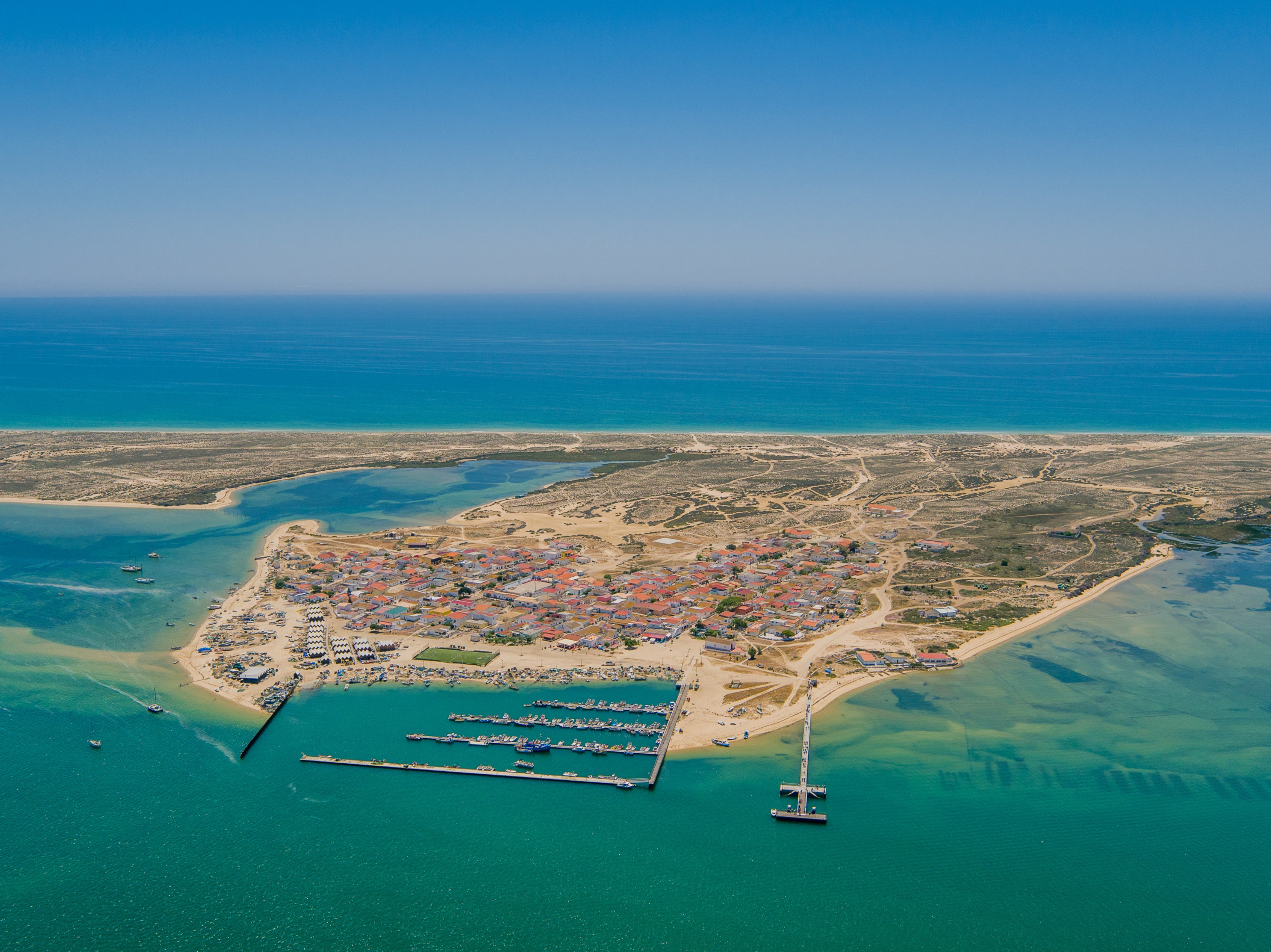
Your support helps us to tell the story
From reproductive rights to climate change to Big Tech, The Independent is on the ground when the story is developing. Whether it's investigating the financials of Elon Musk's pro-Trump PAC or producing our latest documentary, 'The A Word', which shines a light on the American women fighting for reproductive rights, we know how important it is to parse out the facts from the messaging.
At such a critical moment in US history, we need reporters on the ground. Your donation allows us to keep sending journalists to speak to both sides of the story.
The Independent is trusted by Americans across the entire political spectrum. And unlike many other quality news outlets, we choose not to lock Americans out of our reporting and analysis with paywalls. We believe quality journalism should be available to everyone, paid for by those who can afford it.
Your support makes all the difference.In the tiny village of Zambujal, set back from the coast in the heart of the Algarve’s rural east, pigs outnumber people by 10 to one. This is hardly a challenge – the human population is only 15. We’re miles – and a world – away from crowded Albufeira; until recently, a tourist in this location would have caused more comment than if one of those 150 pigs had launched itself into the clear blue sky and flown. Now, things are beginning to change. Word has spread, and visitors are making the drive into these rural foothills to feast on the finest pork products in the region.
Nine years ago, Rui Jeronimo gave up his banking job in Faro and started to farm pigs on 18 hectares of land inherited from his grandfather. It’s hilly, dry, and at times almost barren-looking, with terracotta-tinged soil dusted over hard, granite bedrock. But the hardy Alentejano black pigs – you can tell them by their slender ankles, slim enough to fit in the circle of your finger and thumb – thrive here, feasting not only on their allocated kilo of corn or barley each day, but on what they forage from the land: roots, figs and acorns.
They are truly free-range, as I learn on a wander around the fields. Paulo Marques – who brought his 30 years of experience as a butcher to the job – walks towards the gate, clapping his hands loudly and sending a guttural cry of “Oi! Oi! Oi!” across the valley. So scattered are they, it takes several minutes for a stream of pigs to arrive.
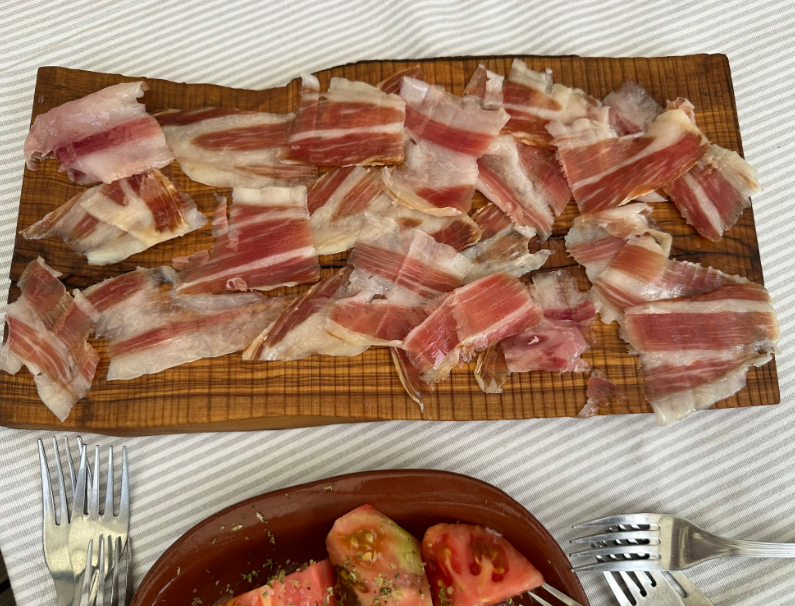
After more than 18 months of this independent existence, it’s “tchau, porcos” (bye, pigs) – Paulo learnt after his first year on the farm not to give the pigs names – and the curing process begins. “We use only natural products, like our grandmothers did,” Rui explains, standing in just one of the many rooms at Feito no Zambujal that are packed from floor to rafter with bits of pig. All sorts of cuts are salted, hung and smoked, but the undisputed king is the presunto, the dry-cured thigh. Paulo lets me have a go at slicing my own, but I soon hand him back the knife and concentrate on stuffing as many sweet, marbled, melting slivers into my mouth as I can.
Read more on Portugal travel:
Most of the farm’s output is snapped up by the best restaurants in the region, but I needn’t shell out for those – my €50 (£43) tour here includes a meal that’s a multi-course celebration of all things pig. Fragrant chourico is basted with balsamic vinegar and homemade honey; herb-coated, succulent ribs are slow-cooked for three hours in the oven; and thin, melting slices of belly pork and savoury cuts of 12-day dry-aged neck are barbecued over open flames, accompanied by the farm’s own red wine (they make 1,000 litres a year, only enough, they tell me, for “personal use”). Just as I think I can eat no more, Rui’s mother arrives bearing a carob cake, warm from the oven.
Luckily, my next stop is less calorific – though just as full of flavour. The sun beats down as I reach Castro Marim, set in a flat basin near the banks of the Guadiana River, sheltered by low dunes from the sea. Just off the road, a series of shallow pools shine in shades of white and pink. The glistening crystals are salt. And not just any salt – these are the finest flor de sal, forming in large pyramids as the water evaporates.
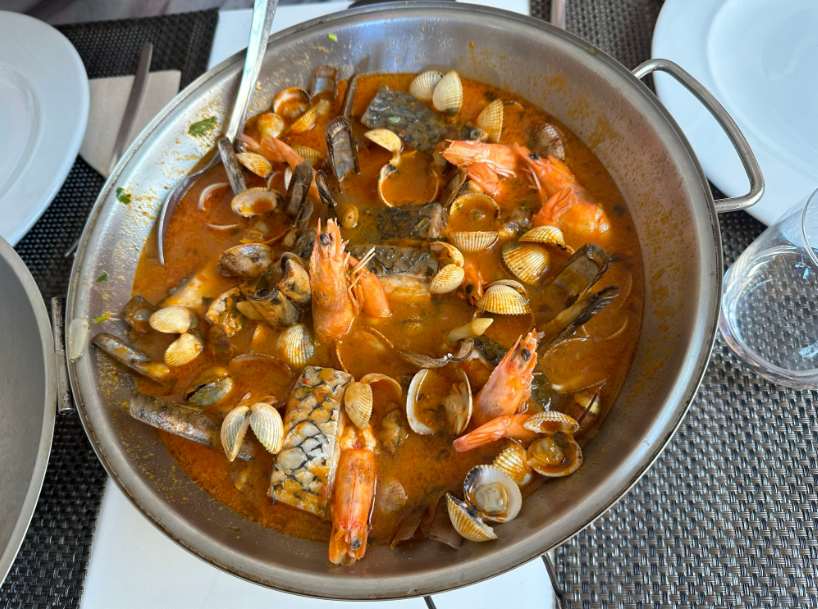
Picking my way between the pools, a pair of black-winged stilts swoop and cry overhead. Jorge Raiado, owner of the Salmarim salt company, indicates why they’re making such a fuss – two speckled eggs are almost invisible in a scraped nest in the mud. This is not only a salt pan, but a nature reserve, and because the salt here is harvested the traditional way, by hand, these nesting birds remain undisturbed.
Using a flat paddle on a long pole, I try my hand at it, scooping the layer of salt gently from the top of the shallow brine. The season runs from June to October, so it’s hot work. Soon it’s time to head inside to try different types of salt, all sprinkled on top of the Algarve’s finest tomatoes. Salmarim supplies restaurants across Portugal and even in the UK, so at the end of my tour and tasting I pick up a pot in the hope that it’ll elevate my home cooking.
We use only natural products, like our grandmothers did
The next morning, I head for the sea. Tourists who make it to the barrier islands that shelter the coast east of Faro often come simply to sunbathe, but despite the translucent water and white sand found on the ocean side, I’m glad to be sticking to the inland coast. During the 10-minute boat trip to Culatra I spot serried ranks of oyster baskets lining the shore, and as I walk from the harbour across the sands my mouth starts to water.
My guide from Portugal4U, Diana, has brought me here to meet Silvia Padinha, the long-time community leader who has been instrumental in preserving the island’s heritage. I catch my first glimpse of her knee-deep in the surf, hauling in a basket, and we’ve barely swapped names before she begins deftly shucking oysters and handing them over. With sand beneath my sandals, just metres from the oyster beds, I’ve never tasted fresher or juicier.
A few minutes later, in the shade of Silvia’s porch, I knock back yet more oysters, raw and steamed, with lemon and shallot vinegar – here they include wine in the mix, too, softening the acidity and allowing the sweetness of the shellfish to sing. We chat about how life on the island has changed, diversifying from the traditional clam-farming into higher-value oysters. Almost all are sold to France – in fact, 10 years ago, French companies tried to buy the land from the fishing community, but Silvia persuaded every resident to maintain their claim and keep the island local.
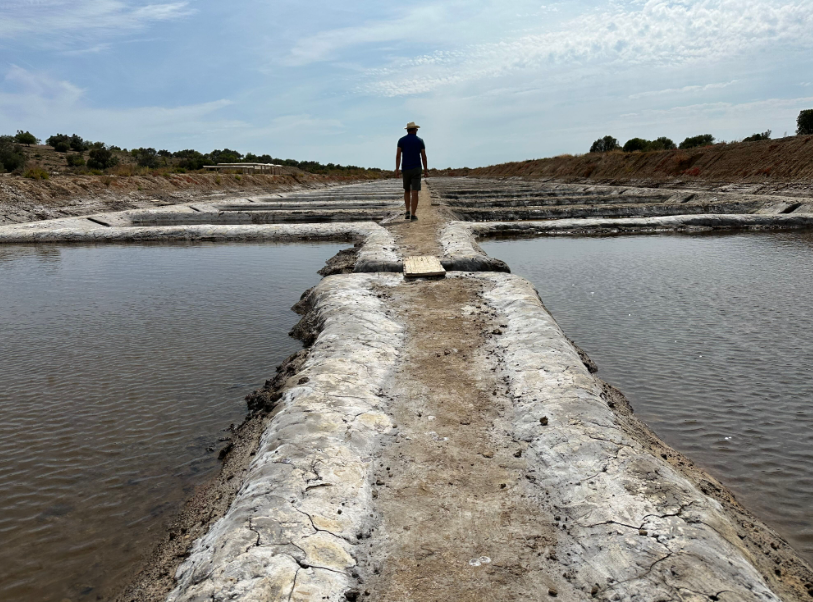
Around 400 families live here, and each owns a portion of the land. There’s a tiny school and a social centre where babies and the elderly are cared for. I spot the island’s only motorised transport, a three-wheel Piaggio Ape, out delivering meals on wheels. Nearly a third of the island’s power needs are met by solar, and Silvia has encouraged the fishermen to collect any rubbish they find while out on their boats. The cooperative, which she leads, has financed the return of 14 families with links to the island, helping them to pay for oyster seeds and keeping them in work until their first harvest, and a community fishing boat works like a food bank.
Even this tour has been developed in partnership with the community, with 20 per cent of the €130 price tag – which includes transport, lunch, tastings and a tour of Olhao, the fishing town back on the mainland – going back into their coffers.
We leave Silvia and head for the clutch of restaurants by the harbour, pulling our chairs around a shaded table and sipping ice-cold Superbock while we wait for our freshly caught golden bream, sea bass, anchovy and tuna to arrive. Simply cooked, with salad and boiled potatoes on the side, they make for the perfect seaside lunch. If time had been on our side, we could have joined those other tourists on the beach for the afternoon, too.
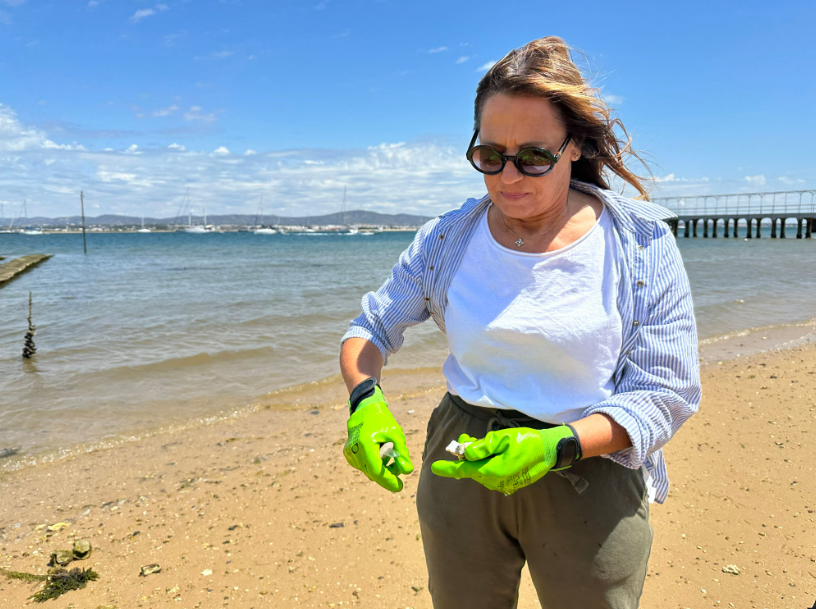
This is the joy of the Algarve. Small-scale, fascinating, tasty experiences sit cheek-by-jowl with the more mainstream tourist areas, so you can slide in a visit somewhere in a spare hour or two. And what better way to end a day than at a winery? Just a couple of miles from the historic town of Silves, crowned by its red-brick, Moorish castle, Quinta dos Sentidos offers private tours and tastings of its small production wines (from €30).
Owners Charlotte Toubro and Beat Buchmann retired here from Switzerland, fell in love with this nine-hectare plot, bumped by chance into an oenologist who wanted to prove that the Algarve could compete with other Portuguese wine regions and, nearly 20 years later, now produce 12,000 bottles of high-quality wine each year.
It’s an idyllic spot, with 650 olive trees, half a million bees, and orchards with more than 100 types of fruit alongside the vines. “Anything subtropical will grow here,” Charlotte says, as we walk past mangoes, lychees, pomelos, yuzu, finger limes and even Citrus medica (citron). She gestures to the spiky, alien-looking fruit: “A Michelin-starred British chef came here and was crazy about it; he made a confit.”
We’ve barely swapped names before she begins deftly shucking oysters and handing them over
In the light-filled tasting room, I try their signature grassy, citrussy white, a half-and-half blend of native antao vaz and arinto grapes, and the berry-rich red, which combines the native touriga nacional and tinta caiada with syrah. But the most fascinating for me is their experimental cru, made from 50 different grapes, local varieties they let grow in small lines in one corner of the vineyard. It’s a blanc noir – white wine made from red grapes – and I’m struck that the complex, mineral flavour would be perfect with a seafood cataplana stew, this region’s most famous dish. I think I’ve found the perfect complement to the flavours of the Algarve.
Algarve specialities and where to try them
Cataplana
This stew, cooked in a traditional, clam-shaped metal pot, is signature to the region; try it at Tertulia Algarvia in Faro. Even better, take their cataplana cooking class (€93) where you’ll shop at the market, make your own, and eat it with wine and dessert.
Weever fish
Known in Portugal as peixe-aranha, or spider fish, its poisonous spines have brought many a swimmer hopping back to the beach. Get your revenge by eating their light, dense flesh floured and fried at O Rui on Culatra.
Piri-piri chicken
Forget Nando’s. The Algarve is the birthplace of piri-piri, and it’s served everywhere. The unassuming town of Guia is home to three giant restaurants where the competition is as hot as the sauce, but I love Marufo in Quarteira, where they use a dry rub instead.
Travel essentials
Getting there
Fly to Faro in under three hours direct from 23 UK airports. Lead-in prices to fly from Gatwick with easyJet start from £65 per person.
Staying there
Hotel Rural Quinta do Marco is a family-friendly yet peaceful countryside retreat in Santa Catarina da Fonte do Bispo, with large, comfortable rooms, an excellent restaurant, and sprawling grounds surrounding a swimming pool. hotelquintadomarco.com
With public areas in a mini-Versailles-style, 18th-century Neoclassical palace and sleek bedrooms plus a pool in a modern wing, Pousada Palacio de Estoi is a best-of-both-worlds hotel in Estoi offering sweeping views all the way to the sea. pousadas.pt
Read more of our best Portugal hotel reviews
Join our commenting forum
Join thought-provoking conversations, follow other Independent readers and see their replies
Comments